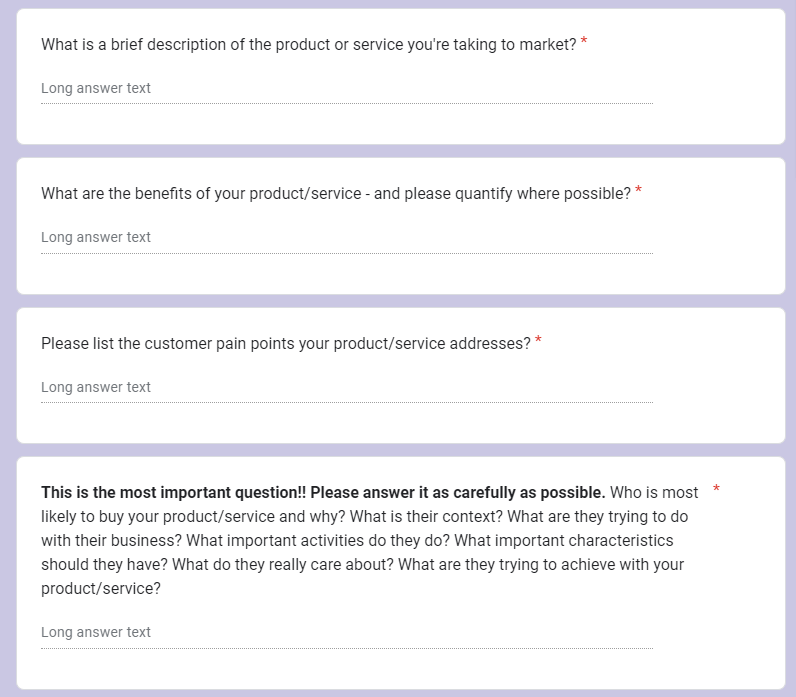Tutorial 3: Crystallise your Proposition and Audience

What Linkedin Outreach Automation does and does NOT do
LinkedIn outreach automation is a tool that accelerates taking an existing product to market.
But it is not a tool that redefines or enhances a product in any way.
Whatever you've got to offer, it'll offer it to more people, faster. But it won't make the offer better.
So you have to have a good offer to begin with, if you want to get the most value out of Linkedin outreach automation.
What does it look like to have a clear proposition?
When you're living and breathing your product or service every single day, it can be hard to take a step back and really see whether your business value proposition hits the mark.
But there are a couple of approaches you can take to get some insight into the quality of your busienss value proposition.
The most obvious approach is to ask people outside of your circle, and preferably people who have not heard of your product or service before. Testing it with people outside of your industry, especially, is a great way to get feedback on clarity.
In the absence of people like this to test with, we also find these questions really helpful - you can step through them by yourself to get a perspective on the quality of your business value proposition:
- Could you write it in less than 300 characters (which is the maximum length of a LinkedIn connection request message)?
- Could your parent or grandparent understand it, if you read it out to them?
- Does it solve a very specific problem or need?
- Does it differentiate your business from any competitors?
- Does it reference persuasive and compelling business value?
If you can honestly answer these questions positively, then you have a clear and compelling proposition that communicates the unique value your business brings.
If you cannot honestly answer at least one of these questions positively, then it may give you a sense of what's missing from your proposition. Sometimes all that is needed for clarity is to break down your offering into more specific products/services for specific audiences. Don't try to cover everything for everyone in one shot.
There are so many resources out there to help with the process of defining a business value proposition and target audience - and below is a selction of some of the ones we think are the most valuable.
Some resources to help you clarify your proposition
There are two elements to having a simple, powerful business value proposition.
The first is: the proposition itself has to be watertight in terms of the problem it's solving, how and for who (product market fit).
The second is: how you communicate it - which has to be as simple as possible.
Here are some resources to help with both of those elements.
Achieving Product Market Fit
You don't have to have perfect Product Market Fit to use LinkedIn Outreach automation, but the closer you are to it, the better your results will be.
There is some great advice available for free online:
-
Websites like TechCrunch, Product Hunt, and Medium (specifically the entrepreneurship and product management sections) offer lots of articles, case studies, and insights from experienced entrepreneurs and product managers. These platforms can provide current trends, tools, and strategies that are beneficial for defining and refining your business proposition and target audience - the essentials for achieving PMF.
-
ycombinator has a lot of useful thinking on Product Market Fit. In particular, here's a great video: https://www.ycombinator.com/library/5z-the-real-product-market-fit. 3 takeaways from this video:
- Product/market fit is signaled not by the number of employees or the funding rounds secured but by overwhelming customer demand and usage that challenges the company's capacity to supply and maintain the product.
- Market First, Solution Second: Entrepreneurs often focus too much on their initial solution. The real genius lies in identifying and committing to solving a pressing market problem, following which the product should evolve through iterations based on customer feedback.
- Find customers with "hair on fire" problems — i.e. issues so urgent and critical that customers will use any available solution, even if it's not perfect. Solutions for these problems can start as imperfect (MVPs), but due to the urgency and need, they can still gain traction, allowing for iterative improvement based on real user feedback.
-
There are also a couple of interesting examples in this Hubspot blog about Spotify and Uber: https://blog.hubspot.com/sales/product-market-fit
If you want to dig deeper into this topic, there are also some great books:
-
Value Proposition Design by Alexander Osterwalder: This book provides a practical framework to help you craft and test great value propositions in a structured way, using the Value Proposition Canvas.
-
The Lean Startup by Eric Ries: Focuses on how to build products that customers actually want. It introduces the concept of the Minimum Viable Product (MVP) to test your business propositions quickly and efficiently.
-
Business Model Generation by Alexander Osterwalder & Yves Pigneur: Offers tools and frameworks for designing, testing, and iterating your business model, helping you understand how your proposition fits into the larger context of your business.
Or there are also some great courses available:
- For enhancing your business proposition and precisely defining your target audience, Coursera offers comprehensive courses. Two standout recommendations include:
- Establishing Product-Market Fit - This course, offered by the University of Maryland, College Park, covers the Lean Product Process, including identifying underserved customer needs, determining your target customer, defining your value proposition, and creating and testing your prototype.
- Creating a Product-Market Fit with Value Proposition Canvas - This guided project helps you use the Value Proposition Canvas (VPC) to align your products and services with what customers truly value. By analyzing a Social Venture startup case study, it provides practical steps for testing product-market fit.
Simplifying the way you communicate your proposition
Even if you have achieved Product Market Fit (PMF), it's still important to work on communicating your proposition as simply and powerfully as possible - although if you've achieved PMF, this is usually much easier.
Some great web-based guidance on strong communication:
-
Shopify provides guidance to its partners on how to create a good value proposition. It emphasizes avoiding hype and focusing on the distinct benefits and concrete value your product delivers. A good value proposition should answer what you do better than anyone else, focusing on aspects like customer service, product design, or price.
- Shopify's take on how to write a value proposition: https://www.shopify.com/id/blog/value-proposition
-
Dave Schoenbeck offers practical steps for simplifying your business, including focusing on important ideas first, measuring valuable metrics, streamlining hiring, re-engineering meetings, fixing outdated business processes, and organizing your workspace and processes
-
His take on how to create a customer value proposition: https://daveschoenbeck.com/the-insiders-guide-on-how-to-create-your-customer-value-proposition/
-
And also his take on how to do sales prospecting: https://daveschoenbeck.com/the-key-to-sales-prospecting-is-to-understand-what-they-think/
-
Some courses that teach customer-centred and value-based communication:
-
Designing a Business, from IDEO U, focuses on combining traditional business strategy with design thinking methods to prototype and test different parts of a business, including the value proposition, revenue model, and sales channel. This course is particularly encourages making your business ideas more customer-centered and innovative.
-
Mastering Marketing: Strategies for Small Business Success, on Udemy, is designed to provide a comprehensive marketing blueprint for small businesses. It covers market research, standing out from the competition, creating products that attract attention, brand positioning, and developing an effective marketing pitch.
-
Turn Your Customer Understanding Into a Value Proposition, by OpenClassrooms, guides you through the process of creating a Business Model Canvas (BMC) and the Value Proposition Canvas. It helps you understand the concept of value exchange between your business and your customers, emphasizing the importance of getting this value right by aligning it more closely with customer needs and preferences.
What to prepare before embarking on a Linkedin outreach campaign
Once you feel comfortable with your value proposition, you can start to bake it into your campaign outreach messages.
The more your messages hit on what the recipient might be thinking or feeling, the more likely you are to resonate and evoke a response.
Should you choose to use Koneksi's personalised messages, here are some example questions we'll ask you to ensure our messages convey your value proposition in as compelling a way as possible for each individual:

And if you're going to write your own mesages, perhaps these questions are a helpful guide in your planning.
Key takeaways
Linkedin outreach automation accelerates and scales the number of people who are being presented with your proposition - so your proposition has to be mature, compelling and simple.
Before you embark on your Linkedin outreach campaign, make sure you are clear on your proposition and your target audience - and the above resources should provide any help you feel you need.
The clearer you are with your proposition, the more you stand to gain from using this tool to offer it to more people faster.



